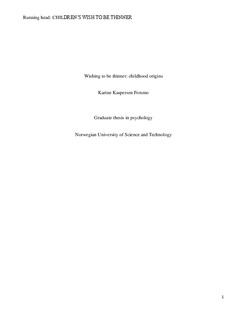Wishing to be thinner - childhood origins
Master thesis
Permanent lenke
http://hdl.handle.net/11250/282601Utgivelsesdato
2014Metadata
Vis full innførselSamlinger
- Institutt for psykologi [3103]
Sammendrag
Wishing to be thinner has been hypothesized to increase the risk of eating disorders. A growing amount of research has established the fact that this wish is already present in childhood, and highlights parents, peers and media as important conveyors of a socio-cultural body ideal, which may promote such a wish. This research has ben limited by the use of cross-sectional data. The present study aimed to extend this research by prospectively examine the prevalence, development, stability and gender differences in an early wish to be thinner, as well as how psychosocial factors predict change in this wish from age 6 to 8 years. Data were obtained from a large community sample of 6 year olds (n=795) and their parents, with a follow-up at age 8. Predictors included children's BMI, gender, appearance satisfaction, emotional overeating, parents' weight concern and media. The results showed that a substantial proportion of the children wished for a thinner figure, i.e. almost half of the children at age 6 and one third at age 8 whereas fewer wished for a larger figure, i.e. one in five and one in 10, respectively. Hence, a larger proportion was satisfied with their current weight at age 8 than at age 6. The wish to be thinner was stronger among girls than boys at age 6. Further, the results showed a moderate stability in the wish to be thinner.
Growth factor modeling revealed that children's BMI, emotional overeating and apperance dissatisfaction predicted an increased wish to be thinner from age 6 to 8, while gender and parents' weight concern had an indirect effect on change in this wish. Possible explanations for study findings are discussed in light of theories concerning sosial and cognitive development. Results suggest that prevention efforts targeting young children's body ideals as well as parents' preoccupation with weight might alleviate an early emerging wish to be thinner.
